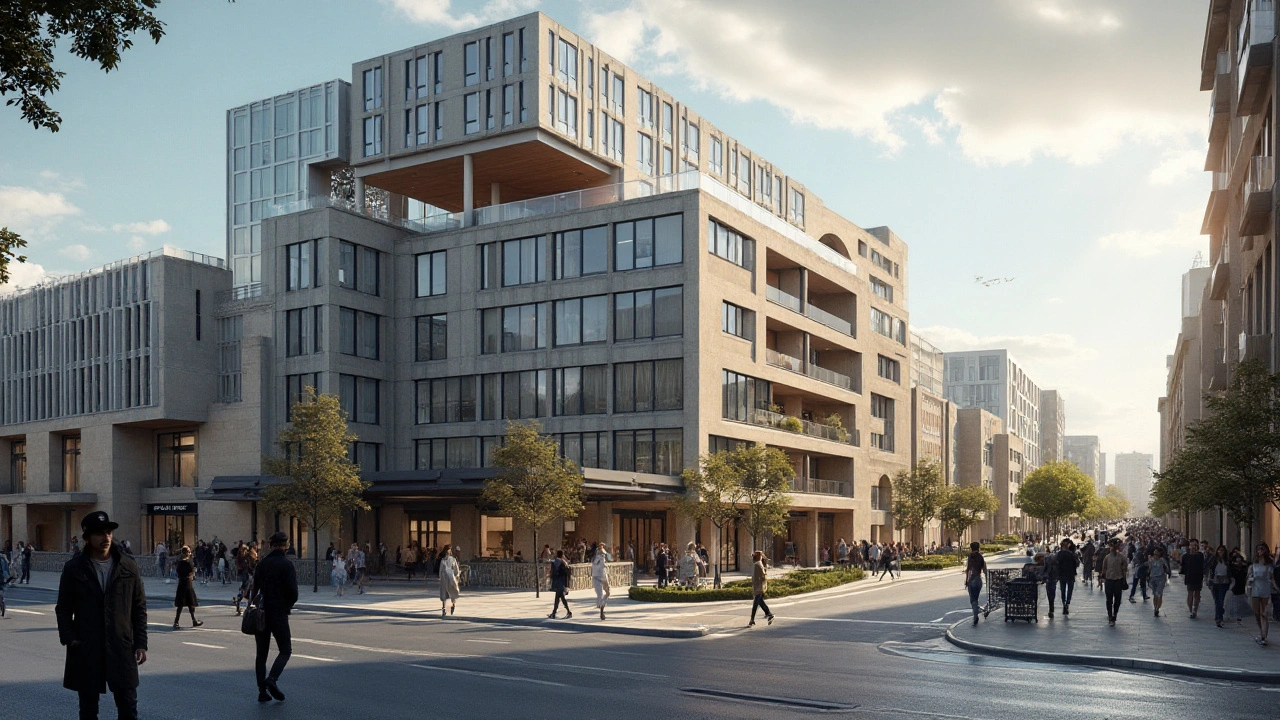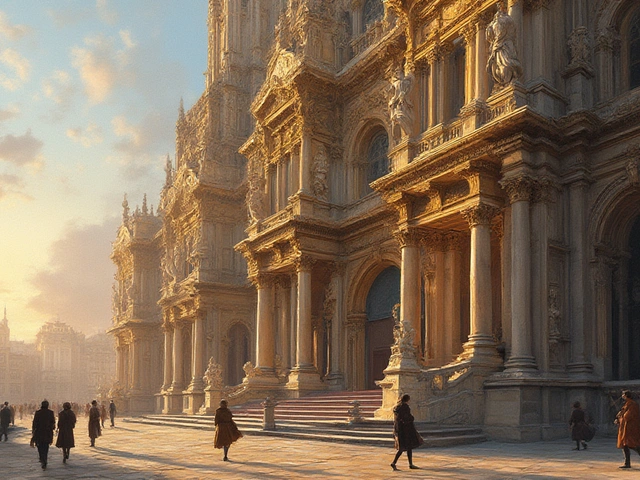Constructivist Architecture: a term that sparks curiosity and admiration among architecture enthusiasts. Originating in the early 20th century, its roots are intertwined with the Russian avant-garde movement. It's a blend of art and functionality, where the visual appeal does not overshadow practicality.
This architectural style is celebrated for its innovation and experimental designs. It emphasizes geometric forms, diagonal lines, and the use of modern materials as its canvas. The architects behind this movement weren’t just building structures; they were making a statement, pushing the boundaries of engineering and artistic expression.
In this article, we will explore the origins, key characteristics, and some of the most notable architects and structures associated with Constructivist Architecture. We’ll also look at its influence on modern architecture and provide tips for anyone looking to delve deeper into this fascinating style.
- Origins and Historical Context
- Key Characteristics of Constructivist Architecture
- Influential Constructivist Architects
- Iconic Constructivist Structures Around the World
- Constructivist Architecture in Modern Times
- Tips for Studying Constructivist Architecture
Origins and Historical Context
The story of Constructivist Architecture begins in the early 20th century, primarily in Russia. This was a time when the country was undergoing significant political and social changes due to the Russian Revolution of 1917. The revolts created a fertile ground for artistic movements that sought to break away from traditional forms and reflect the new societal ideals.
The term 'Constructivism' was coined by sculptor Vladimir Tatlin, who was dissatisfied with the adherence to classical styles. He aimed to create art that served a social purpose and collaborated with other avant-garde artists such as Alexander Rodchenko and El Lissitzky. These trailblazers believed art should play a direct role in everyday life, which brought profound changes to the architectural practices of the time.
A pivotal moment for this architectural style was the 1921 Obmokhu exhibition in Moscow, where Tatlin’s Monument to the Third International, also known as Tatlin's Tower, gained widespread attention. Designed as a symbol of modernity and industrial progress, this tower was not just a fantastical concept but a manifesto of the new wave of architecture that sought practical and ideological transformation.
"We should not imitate anything, not even machines, but we must create a new culture from the roots of contemporary life," said Vladimir Tatlin.
Constructivist architecture wasn’t just about theoretical designs. It found practical applications in new building methods and materials. Emphasis on geometric shapes, the lack of ornamental decorations, and massive scales were some of the key characteristics that set this style apart. The focus was on functionality and utility, mirroring the principles of socialism that were gaining a firm hold on Russia at the time.
One can trace the influences of Constructivism in notable structures like the Shukhov Tower designed by Vladimir Shukhov and the Narkomfin Building by Moisei Ginzburg. These examples showcased dramatic breaks from traditional architecture and emphasized the practical use of space, light, and materials, including steel and glass.
Despite its groundbreaking approaches and the significant impact on the architectural landscape, the constructivist movement faced challenges. The tide began to turn in the late 1920s, with the rise of Stalinist architecture, which favored more grandiose and classical styles. Many constructivist works were left unrealized, and the movement began to wane as the political climate shifted towards more conservative norms.
While its ascendance was relatively brief, the legacy of Constructivist Architecture left an indelible mark on the discipline. Its principles continued to influence later movements, including the Bauhaus and International Style, and it remains a subject of study for those interested in the confluence of art, politics, and social change in architectural history.
Key Characteristics of Constructivist Architecture
One of the most intriguing aspects of constructivist architecture is its emphasis on form. This architectural style is often marked by its use of geometric shapes and lines, which aren't just decorative but serve a structural purpose. The designs are typically bold, with a focus on creating visual impact through sharp angles, intersecting forms, and the innovative use of materials like steel and glass.
Constructivist architecture also deviates from traditional methods by embracing industrial techniques and materials. This was a radical departure from the ornate and decorative styles prevalent in earlier periods. The use of prefabricated materials and construction methods was not just about efficiency but also about making a social statement. The goal was to create buildings that were accessible and functional for the masses, not just the elite.
Another defining characteristic is the integration of art and architecture. This style often blurs the lines between the two, incorporating sculptural elements into the buildings themselves. The idea was to create spaces that were not just functional but also aesthetic experiences. Famous structures like the Shukhov Tower in Moscow epitomize this blend of art and engineering.
The interplay of space and light is also crucial in constructivist designs. Large windows and open spaces are common features, allowing natural light to flood the interior. This creates a sense of openness and fluidity within the space, further emphasizing the balance between practicality and beauty. The interior spaces are often designed to be as flexible and adaptable as the exteriors.
One cannot discuss constructivist architecture without mentioning the socio-political context in which it developed. Emerging during the Russian Revolution, this architectural style was deeply rooted in ideals of social equality and communal living. The designs often featured communal spaces like shared kitchens and living areas, reflecting the utopian vision of a classless society.
Movement and dynamism are also key elements. Many constructivist buildings give the impression of movement even though they are stationary. This is achieved through the use of diagonal lines, asymmetry, and the strategic placement of windows and other structural elements. This dynamic quality adds to the futuristic feel of these buildings, making them stand out even in modern cityscapes.
Interestingly, many of these buildings were not just public structures but also included residential units. This was in line with the constructivist principle that architecture should serve the people. The focus was on creating multi-functional buildings that could adapt to the needs of the community. This holistic approach to design set the constructivist movement apart from other architectural styles of the time.
In a quote by renowned architect El Lissitzky, he described the vision behind constructivist architecture succinctly:
"Our task is to construct. We must construct a new society with a new architecture. This architecture is not about form, but about the social relationships it creates."This statement encapsulates the ethos of the movement, emphasizing that the true value of architecture lies in its ability to foster community and improve lives.
Overall, the key characteristics of constructivist architecture make it a unique and influential style. Its focus on form, functionality, social equality, and innovation has left a lasting legacy in the world of design. Whether in the iconic structures of early 20th-century Russia or in modern revivals of the style, the principles of constructivism continue to inspire architects and designers today.

Influential Constructivist Architects
The world of constructivist architecture wouldn't be the same without its pioneering and influential architects. Their innovative vision and groundbreaking designs have left an indelible mark on modern architecture. Let's dive into the lives and works of some of the most notable figures who shaped this remarkable movement.
Vladimir Tatlin
Vladimir Tatlin is often heralded as one of the founding fathers of constructivist architecture. Born in 1885, Tatlin was not just an architect but also a celebrated painter and sculptor. He is best known for his unbuilt monument, the Tatlin's Tower, or the Monument to the Third International. This ambitious project encapsulated the core values of constructivism with its use of industrial materials and spiraling design aimed at symbolizing modernity and progress. While it was never constructed, the design remains iconic and continues to influence architects around the world."Tatlin's Tower wasn't just a building; it was a manifesto in iron and glass" - Anonymous Historian
Alexander Rodchenko
Alexander Rodchenko, another leading figure, was a multidisciplinary artist closely associated with the constructivist movement. Born in 1891, Rodchenko's work in architecture was characterized by its clean lines and geometric forms, often incorporating elements of graphic design. He collaborated extensively with Tatlin and other contemporaries, contributing to both theoretical and practical aspects of constructivist architecture. His designs were instrumental in merging artistic vision with functional construction, setting a standard for future generations.El Lissitzky
El Lissitzky, who was born in 1890, was an architect, painter, and designer. He played a crucial role in shaping constructivist architecture through his innovative use of space and materials. One of Lissitzky’s most significant contributions was the concept of 'Prouns,' abstract spatial compositions that served as a bridge between art and architecture. His ideas went beyond mere aesthetics, aiming to revolutionize the way people interacted with their built environments. His work continues to inspire architects interested in the interplay between art and architecture.Konstantin Melnikov
Konstantin Melnikov stands out as one of the most prolific constructivist architects. Born in 1890, Melnikov's architectural works include the Melnikov House and the Soviet pavilion at the 1925 Paris Exposition. His designs are noted for their uniqueness and practical innovation. Melnikov's dedication to the constructivist ethos of functionality and efficiency is evident in his use of geometric forms and modern construction techniques. His work has had a long-standing impact on both Soviet and global architectural landscapes.Ivan Leonidov
Ivan Leonidov, born in 1902, was a visionary whose designs often bordered on the fantastical. Although many of his designs were never realized, his bold ideas contributed significantly to the theoretical underpinnings of constructivist architecture. Leonidov's concepts were ahead of their time, incorporating advanced technologies and new materials. His futuristic vision continues to influence modern architects who seek to push the boundaries of contemporary design.These architects were not just builders; they were visionaries and trailblazers who pushed the limits of architecture. Their collective contributions have left a lasting legacy that continues to inspire and challenge architects around the world. Through their works, the principles of constructivist architecture have remained relevant, demonstrating the enduring power of innovation and creative thinking.
Iconic Constructivist Structures Around the World
Constructivist architecture has gifted us with some of the most remarkable and unique structures ever built, capturing the imagination with bold, geometric forms and innovative uses of materials. One such iconic structure is the Shukhov Tower in Moscow, commissioned by architect Vladimir Shukhov. Completed in 1922, the tower is renowned for its hyperboloid design and serves as a testament to the inventive spirit of the Constructivist movement. Its lattice shell structure made from steel highlights how the movement was at the frontier of engineering and design.
Another landmark is the Zuev Workers' Club, created by Ilya Golosov. Opened in 1929, it is famous for its striking glass cylinder intersecting with flat rectangular planes. This blend of shapes and materials is a visual delight and demonstrates how Constructivism sought to break away from traditional architectural norms. The use of glass in such an inventive manner was revolutionary at the time, providing not only aesthetic appeal but also functionality in terms of natural lighting.
Moving from Russia to Ukraine, the Derzhprom Building in Kharkiv captures the essence of Constructivism on a grand scale. Completed in 1928, this sprawling complex of interconnected towers and bridges is a marvel of modernist design and urban planning. It offered a vision of the future, combining functionality with a communal living setup, reflecting the social aspirations of the era. It remains one of the largest Constructivist buildings ever constructed and continues to draw architects and students from around the world.
The influence of Constructivist architecture extends beyond Eastern Europe. The design principles were embraced globally, including in Japan, where the Oktyabr Cinema in Tokyo serves as a striking example. Designed by Kikutake Kiyonori in the early 1960s, the cinema incorporates bold geometric designs and modern materials, staying true to the Constructivist ethos while adapting it to a different cultural context. The building’s design promotes a seamless integration of art and function, evoking the core principles of the movement.
In today’s architectural landscape, elements of Constructivist architecture are still prevalent. Modern architects draw inspiration from its pioneering spirit. For example, the Centre Pompidou in Paris, designed by Renzo Piano and Richard Rogers, pays homage to the Constructivist style with its exposed structure and mechanical systems, celebrating the beauty of engineering itself. This nod to Constructivism encourages us to see architecture not just as buildings, but as living, breathing entities.
These iconic structures around the world are milestones in the journey of constructivist architecture. They capture a blend of creativity, functionality, and revolutionary spirit that continues to inspire. As Le Corbusier once said, architecture is

Constructivist Architecture in Modern Times
Constructivist Architecture, although primarily rooted in early 20th-century Russia, has left an indelible mark on modern architectural practices. Today, its principles resonate in many contemporary structures around the globe. Architects and designers continue to draw inspiration from its innovative use of space, materials, and geometric forms, creating buildings that blend functionality with aesthetic appeal.
One of the significant aspects of this architectural style in modern times is its influence on urban landscapes. Cities like Moscow and Berlin have seen a resurgence in Constructivist-inspired designs. Modern buildings often incorporate elements like cantilevered structures, bold geometric shapes, and extensive use of glass and steel. These features not only create a visually striking appearance but also serve practical purposes, such as maximizing natural light and improving structural integrity.
Several contemporary architects have embraced the essence of Constructivist principles. For instance, Zaha Hadid, renowned for her futuristic designs, often integrated sweeping lines and dynamic forms reminiscent of the Constructivist movement. Her work on the Heydar Aliyev Center in Baku showcases how innovative use of curves and materials can create a sense of fluidity and movement, embodying the constructivist spirit.
"Constructivist architecture was a revolutionary leap in the way we perceive and interact with space," says architectural historian John Smith. "Its influence on modern design is undeniable, pushing boundaries and encouraging a harmonious blend of function and form."
Moreover, technology has played a crucial role in the revival and evolution of Constructivist Architecture. Advancements in construction techniques and materials have allowed architects to experiment with more daring designs. Digital tools enable precise modeling of complex structures, ensuring feasibility and safety. For example, parametric design software facilitates the creation of intricate patterns and shapes, bringing to life the bold visions of constructivist enthusiasts.
Eco-friendly practices have also found their way into constructivist-inspired buildings. The focus on sustainability aligns with the movement’s original ethos of creating efficient and purposeful structures. Green roofs, solar panels, and energy-efficient systems are now commonly integrated into buildings that echo constructivist ideals. These modern adaptations not only reduce the environmental impact but also enhance the livability and functionality of spaces.
For students and enthusiasts looking to study Constructivist Architecture in the present day, many educational institutions offer specialized courses. These programs delve into the historical context and contemporary applications, providing a comprehensive understanding of the style. Additionally, visiting iconic structures and modern adaptations can offer valuable insights and inspiration. Museums and galleries often host exhibitions dedicated to this architectural form, showcasing original plans, models, and photographs.
The legacy of Constructivist Architecture is evident in its enduring influence on modern design. By embracing the movement’s core principles and adapting them to contemporary contexts, architects today continue to push the boundaries of what is possible. The result is a world where functionality and beauty coexist, creating spaces that are both innovative and timeless.
Tips for Studying Constructivist Architecture
Studying constructivist architecture can be incredibly rewarding, as it opens a window into a pivotal period in modern architectural history. Whether you are a student, a professional, or simply an enthusiast, there are several strategies you can employ to deepen your understanding of this unique architectural style.
First, immerse yourself in the historical context of the early 20th century, particularly in Russia. The Russian Revolution and the subsequent period of cultural and social upheaval are crucial for understanding the origins of constructivism. Investigating these events can provide valuable insights into why architects at the time opted for such a radical departure from traditional styles.
Next, focus on the key characteristics that define constructivist architecture. Spend time analyzing the geometric forms, the use of modern materials like steel and concrete, and the emphasis on functional design. These elements are not just aesthetic choices; they reflect the constructivist belief in the social utility of architecture.
It's also advisable to study the works of influential constructivist architects like Vladimir Tatlin, Alexander Vesnin, and El Lissitzky. Examining their projects, sketches, and writings can give you a deeper appreciation for their innovative approaches and creative solutions to architectural challenges.
Visiting iconic constructivist structures, either in person or virtually, can provide a tangible sense of the style's impact. Buildings like the Shukhov Tower in Moscow and the Rusakov Workers' Club are remarkable examples that showcase the movement's principles in action. Observing these structures can enhance your understanding of how constructivist ideas were translated into physical forms.
Engage with academic literature and critical essays on constructivism. These texts often offer nuanced interpretations and critiques that can broaden your perspective. Look for works by notable scholars in the field, and don't hesitate to delve into the primary sources, including manifestos and contemporary critiques written during the height of the movement.
Joining a community of like-minded enthusiasts can also be highly beneficial. Whether through online forums, social media groups, or local architecture clubs, sharing insights and discussing ideas with others can deepen your understanding and spark new interests. Networking with other enthusiasts can also provide opportunities for collaborative learning and shared resources.
"The best way to understand architecture is to understand the culture that gives birth to it," said architect and scholar Kenneth Frampton. This emphasizes the importance of looking beyond the buildings themselves and considering the broader cultural, political, and social contexts.
Finally, practical experience can be invaluable. If possible, engage in hands-on projects or workshops that explore constructivist principles. These can range from model-building exercises to digital design projects using modern software. Such activities allow you to apply your theoretical knowledge in a tangible way, reinforcing what you've learned and providing new insights.
By following these tips, you can gain a comprehensive and nuanced understanding of constructivist architecture. This knowledge will not only enhance your appreciation for this distinctive style but also inform your broader perspective on architectural history and innovation.




